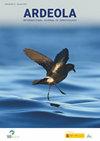影响电线上鸟类碰撞死亡率差异低估的因素:加那利群岛的案例研究
IF 1.2
4区 生物学
Q2 ORNITHOLOGY
引用次数: 13
摘要
由于三个主要的偏差来源,屠体计数明显低估了鸟类碰撞率:不完善的检测、食腐动物清除屠体和屠体在未搜索区域的分散。我们在两个加那利群岛,兰萨罗特岛和富埃特文图拉岛的电力线上评估了这些偏差来源,量化了影响它们的因素。我们还对垂直于电力线轴线进行的尸体搜寻进行了成本效益评估。在2015年7月、2015年11 - 12月和2016年3月三个时间段,我们调查了230公里的三种类型的电线(高压、中压和电话线),寻找碰撞死亡人数(N = 431),记录了物种、与电线的尸体距离、平均电缆高度、尸体检测距离和分解状态。此外,我们还进行了一个消失率实验来估计腐食动物对尸体的清除。采用广义最小二乘模型分析了胴体与电线的分散距离与物种体重、平均电缆高度和电线类型的关系。将胴体质量、分解状态和栖息地结构作为协变量,拟合检测概率函数来估计胴体可检出性。采用广义混合效应模型分析胴体消失与胴体放置时间、胴体大小、季节和岛屿之间的关系。色散距离随身体质量的增加而减小,随电缆高度的增加而增大,在高压线路上色散距离更大。总体而言,检测概率为0.134,随胴体尺寸增大而增大,随分解状态减小而减小,在岩石地区检测概率较低,岩石地区对行走崎岖地形具有较大挑战。不同岛屿之间的消失率不同,可能是由于鸟类食腐动物丰度的差异,随着时间的流逝而增加,随着鸟的大小而减少。这项研究提供了校正因子,以获得在植被稀疏的景观中鸟类死亡率的无偏估计。此外,它还确定了一个27米的阈值距离,在这个阈值距离内,搜索尸体的成本效益是最优的。-Gomez-Catasus, J., Carrascal, l.m., Moraleda, V., Colsa, J., Garces, F. & Schuster, C.(2021)。影响电线上鸟类碰撞死亡人数差异低估的因素:加那利群岛案例研究。农业学报,68:71-94。本文章由计算机程序翻译,如有差异,请以英文原文为准。
Factors Affecting Differential Underestimates of Bird Collision Fatalities at Electric Lines: A Case Study in the Canary Islands
Carcass counts notably underestimate avian collision rates due to three main bias sources: imperfect detection, carcass removal by scavengers and carcass dispersion in unsearched areas. We assessed these sources of bias at electric lines of two Canary Islands, Lanzarote and Fuerteventura, quantifying the factors influencing them. We also carried out a cost-effectiveness assessment of carcass search done perpendicularly to electric line axis. We surveyed 230km of three types of electric lines (high-voltage, medium voltage and telephone lines) during three periods (July 2015, November-December 2015 and March 2016) searching for collision fatalities (N = 431), recording the species, the carcass distance from the electric line, mean cable height, carcass detection distance and decomposition state. In addition, we carried out a disappearance rate experiment to estimate carcass removal by scavengers. A generalised least squares model was used to analyse dispersion distance of carcass from electric lines, in relation to species body mass, mean cable height and line typology. Detection probability functions were fitted to estimate carcass detectability, incorporating body mass, decomposition state and habitat structure as covariates. A Generalised Mixed-Effects model was carried out to analyse carcass disappearance in relation to time elapsed since carcass placement, carcass size, season and island. Dispersion distance decreased with body mass and increased with cable height, being further at high-voltage lines. Overall, detection probability was 0.134, increasing with carcass size, decreasing with decomposition state and being lower in rocky areas which offered a significant challenge when walking through rough terrain. Disappearance rates differed between islands probably due to differences in avian scavenger abundance, increased with time elapsed and decreased with bird size. This study provides correction factors to obtain unbiased estimates of avian mortality rates within sparsely vegetated landscapes. Moreover, it identifies a 27m threshold distance at which the cost-effectiveness of searching for carcasses is optimised.—Gomez-Catasus, J., Carrascal, L.M., Moraleda, V., Colsa, J., Garces, F. & Schuster, C. (2021). Factors affecting differential underestimates of bird collision fatalities at electric lines: a case study in the Canary Islands. Ardeola, 68: 71-94.
求助全文
通过发布文献求助,成功后即可免费获取论文全文。
去求助
来源期刊
CiteScore
2.30
自引率
6.20%
发文量
16
审稿时长
>12 weeks
期刊介绍:
Ardeola: International Journal of Ornithology is the scientific journal of SEO/BirdLife, the Spanish Ornithological Society. The journal had a regional focus when it was first published, in 1954. Since then, and particular during the past two decades, the journal has expanded its thematic and geographical scope. It is now a fully international forum for research on all aspects of ornithology. We thus welcome studies within the fields of basic biology, ecology, behaviour, conservation and biogeography, especially those arising from hypothesis-based research. Although we have a long publication history of Mediterranean and Neotropical studies, we accept papers on investigations worldwide.
Each volume of Ardeola has two parts, published annually in January and July. The main body of each issue comprises full-length original articles (Papersand Review articles) and shorter notes on methodology or stimulating findings (Short Communications). The publication language is English, with summaries, figure legends and table captions also in Spanish. Ardeolaalso publishes critical Book Reviewsand PhD-Dissertation Summaries; summarising ornithological theses defended in Spain. Finally there are two Spanish-language sections, Ornithological News; summarising significant recent observations of birds in Spain, and Observations of Rare Birds in Spain, the annual reports of the Spanish Rarities Committee.

 求助内容:
求助内容: 应助结果提醒方式:
应助结果提醒方式:


